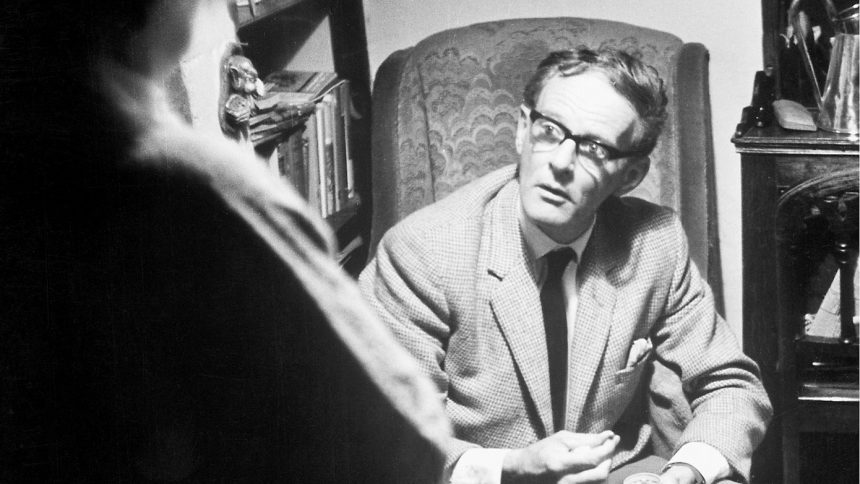The fortunate man here is the doctor.
Sassall meets anguished patients on his rounds – the close relatives of the dying, those who are ill and want to die, the immobilized who are made desperate by a kind of claustrophobic fear of their own bodies, the insanely jealous, the lonely who try to kill themselves, the hysterics; sometimes he is able to reach them: sometimes it is obvious that he never will.
He deals with all emergencies which arise – from serious accidents in the quarries or at harvesting time in the fields, to the despair of a young woman who wants to kill her illegitimate baby, or the slow suffering and eventual collapse of a retired vicar who has lost his faith. He is trusted, almost without question.
It is generally assumed that doctors take a professional view of suffering and that the process of professional insulation begins when they first start dissecting the human body. This is true. But the question is far deeper than overcoming any physical revulsion at the sight of blood or guts.
When he was unaware of my presence, I saw him weep, walking across a field away from a house where a young patient was dying.
He never separates an illness from the total personality of the patient – in this sense he is the opposite of a specialist. He does not believe in maintaining this imaginative distance: he must come close enough to recognize the patient fully.
Is he not an outdated nineteenth-century romantic with his ideal of single personal responsibility? And in the last analysis is not this ideal a form of paternalism? He himself is aware of the implications of such criticism.
Extracts from A Fortunate Man, by John Berger and Jean Mohr (1967), published in 2015 by Canongate, at the suggestion of and with an introduction by Edinburgh GP and author Gavin Francis. (C), reproduced by permission of Yves Berger.
Commentary
John Berger describes the practice of John Sassall, a GP in rural Gloucestershire. Sassall was at first a reluctant GP. He had come out of medical school and into his early professional career with a very mechanical, fix-it approach, intending a surgical career.
Early, he continued in this manner. But gradually, he comes to an understanding of the importance of the lives of his patients behind their diseases and symptoms. What mattered to them, what made them unwell, and how understanding that made it easier for the doctor to improve their lives too – to heal. By the time this account was written, he was regarded as a good and remarkable man, dedicated to his patients.
It is a short book, text interspersed with photos by Jean Mohr. The brief chapters are lyrically written, moving to read. A Fortunate Man quickly became widely praised for its insights into the motivation, privilege, and potential rewards of working in general practice. Sassall had been Berger’s own GP in Gloucestershire. Mohr was a Swiss photographer particularly known for portraying the plight of Palestinian refugees.
The integration of the doctor into the life of the local community is a powerful theme, as in Eugene Smith’s photostory of the Colorado GP John Ceriani almost twenty years earlier. But many in other specialties record a similar shift in their attitude to patients with time. This shapes approaches to individual patients – realistic and personalised medicine.
I sometimes wonder, he says, how much of me is the last of the old traditional country doctor and how much of me is a doctor of the future. Can you be both?
There have been two particular criticisms of the book. First, that it leaves out mention of the essential role of Sassall’s wife. After she died, Sassall left general practice. This seems particularly surprising in the light of Berger’s later, essentially feminist, critique of the portrayal of women in painting. But Berger explicitly states in a footnote that his intention was to keep the story simply and narrowly focused on the doctor’s professional life.
Secondly, does it idealise an unsustainable level of dedication to medical practice? Most commentators think not, instead concluding that it makes work, and therefore life, more rewarding. But that is for debate and personal discovery.
Further info
- Gavin Francis on A Fortunate Man – it is worth reading this extended commentary, which gives detailed background on how the book came to be written, and its influence. He quotes a 1967 reviewer, and many have said the same: “I am grateful for it.”
- Extracts by permission of Yves Berger.
- John Berger (1926-2017) was a renowned art critic, novelist, and also a painter and poet. Probably best known was his very influential, radical, ‘Marxist-lite’ and feminist look at how we view paintings in Ways of Seeing, a book and TV series that came out 5 years after this book, in 1972. Wikipedia on Berger. [Ways of Seeing TV series, Youtube]
- Image: Jean Mohr‘s photographs are as important as the text in creating the lyrical feel of the book.
Contributed by
Neil Turner

